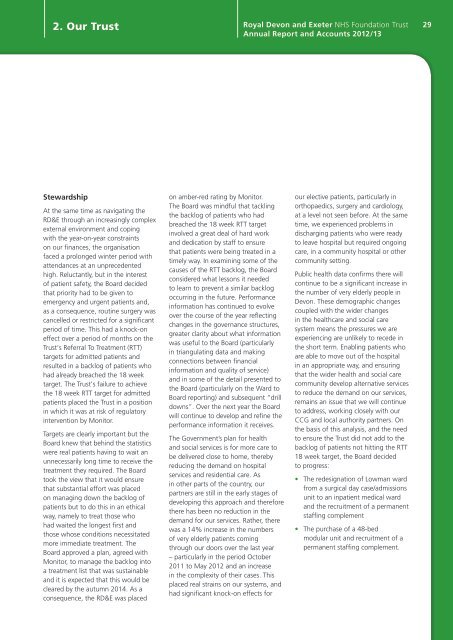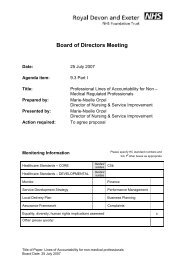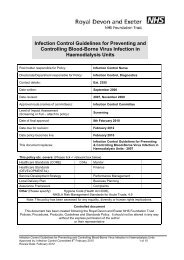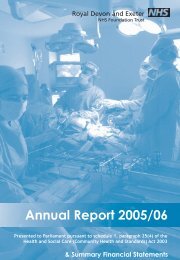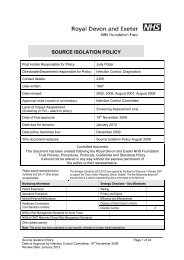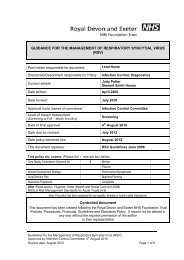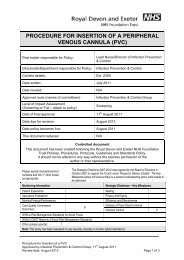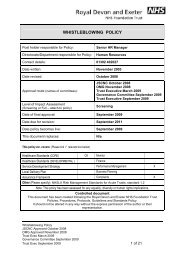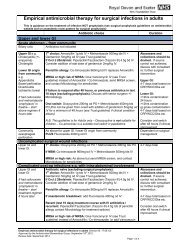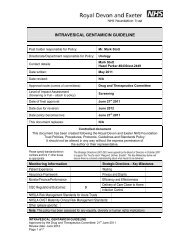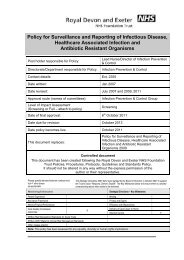Annual Report and Accounts 2012/13 - Royal Devon & Exeter Hospital
Annual Report and Accounts 2012/13 - Royal Devon & Exeter Hospital
Annual Report and Accounts 2012/13 - Royal Devon & Exeter Hospital
You also want an ePaper? Increase the reach of your titles
YUMPU automatically turns print PDFs into web optimized ePapers that Google loves.
2. Our Trust <strong>Royal</strong> <strong>Devon</strong> <strong>and</strong> <strong>Exeter</strong> NHS Foundation Trust 29<br />
<strong>Annual</strong> <strong>Report</strong> <strong>and</strong> <strong>Accounts</strong> <strong>2012</strong>/<strong>13</strong><br />
Stewardship<br />
At the same time as navigating the<br />
RD&E through an increasingly complex<br />
external environment <strong>and</strong> coping<br />
with the year-on-year constraints<br />
on our finances, the organisation<br />
faced a prolonged winter period with<br />
attendances at an unprecedented<br />
high. Reluctantly, but in the interest<br />
of patient safety, the Board decided<br />
that priority had to be given to<br />
emergency <strong>and</strong> urgent patients <strong>and</strong>,<br />
as a consequence, routine surgery was<br />
cancelled or restricted for a significant<br />
period of time. This had a knock-on<br />
effect over a period of months on the<br />
Trust's Referral To Treatment (RTT)<br />
targets for admitted patients <strong>and</strong><br />
resulted in a backlog of patients who<br />
had already breached the 18 week<br />
target. The Trust's failure to achieve<br />
the 18 week RTT target for admitted<br />
patients placed the Trust in a position<br />
in which it was at risk of regulatory<br />
intervention by Monitor.<br />
Targets are clearly important but the<br />
Board knew that behind the statistics<br />
were real patients having to wait an<br />
unnecessarily long time to receive the<br />
treatment they required. The Board<br />
took the view that it would ensure<br />
that substantial effort was placed<br />
on managing down the backlog of<br />
patients but to do this in an ethical<br />
way, namely to treat those who<br />
had waited the longest first <strong>and</strong><br />
those whose conditions necessitated<br />
more immediate treatment. The<br />
Board approved a plan, agreed with<br />
Monitor, to manage the backlog into<br />
a treatment list that was sustainable<br />
<strong>and</strong> it is expected that this would be<br />
cleared by the autumn 2014. As a<br />
consequence, the RD&E was placed<br />
on amber-red rating by Monitor.<br />
The Board was mindful that tackling<br />
the backlog of patients who had<br />
breached the 18 week RTT target<br />
involved a great deal of hard work<br />
<strong>and</strong> dedication by staff to ensure<br />
that patients were being treated in a<br />
timely way. In examining some of the<br />
causes of the RTT backlog, the Board<br />
considered what lessons it needed<br />
to learn to prevent a similar backlog<br />
occurring in the future. Performance<br />
information has continued to evolve<br />
over the course of the year reflecting<br />
changes in the governance structures,<br />
greater clarity about what information<br />
was useful to the Board (particularly<br />
in triangulating data <strong>and</strong> making<br />
connections between financial<br />
information <strong>and</strong> quality of service)<br />
<strong>and</strong> in some of the detail presented to<br />
the Board (particularly on the Ward to<br />
Board reporting) <strong>and</strong> subsequent “drill<br />
downs”. Over the next year the Board<br />
will continue to develop <strong>and</strong> refine the<br />
performance information it receives.<br />
The Government’s plan for health<br />
<strong>and</strong> social services is for more care to<br />
be delivered close to home, thereby<br />
reducing the dem<strong>and</strong> on hospital<br />
services <strong>and</strong> residential care. As<br />
in other parts of the country, our<br />
partners are still in the early stages of<br />
developing this approach <strong>and</strong> therefore<br />
there has been no reduction in the<br />
dem<strong>and</strong> for our services. Rather, there<br />
was a 14% increase in the numbers<br />
of very elderly patients coming<br />
through our doors over the last year<br />
– particularly in the period October<br />
2011 to May <strong>2012</strong> <strong>and</strong> an increase<br />
in the complexity of their cases. This<br />
placed real strains on our systems, <strong>and</strong><br />
had significant knock-on effects for<br />
our elective patients, particularly in<br />
orthopaedics, surgery <strong>and</strong> cardiology,<br />
at a level not seen before. At the same<br />
time, we experienced problems in<br />
discharging patients who were ready<br />
to leave hospital but required ongoing<br />
care, in a community hospital or other<br />
community setting.<br />
Public health data confirms there will<br />
continue to be a significant increase in<br />
the number of very elderly people in<br />
<strong>Devon</strong>. These demographic changes<br />
coupled with the wider changes<br />
in the healthcare <strong>and</strong> social care<br />
system means the pressures we are<br />
experiencing are unlikely to recede in<br />
the short term. Enabling patients who<br />
are able to move out of the hospital<br />
in an appropriate way, <strong>and</strong> ensuring<br />
that the wider health <strong>and</strong> social care<br />
community develop alternative services<br />
to reduce the dem<strong>and</strong> on our services,<br />
remains an issue that we will continue<br />
to address, working closely with our<br />
CCG <strong>and</strong> local authority partners. On<br />
the basis of this analysis, <strong>and</strong> the need<br />
to ensure the Trust did not add to the<br />
backlog of patients not hitting the RTT<br />
18 week target, the Board decided<br />
to progress:<br />
• The redesignation of Lowman ward<br />
from a surgical day case/admissions<br />
unit to an inpatient medical ward<br />
<strong>and</strong> the recruitment of a permanent<br />
staffing complement<br />
• The purchase of a 48-bed<br />
modular unit <strong>and</strong> recruitment of a<br />
permanent staffing complement.


